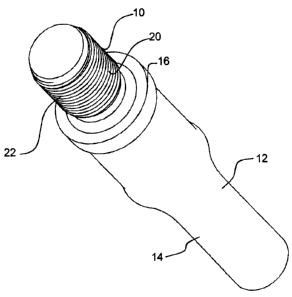Une partie des informations de ce site Web a été fournie par des sources externes. Le gouvernement du Canada n'assume aucune responsabilité concernant la précision, l'actualité ou la fiabilité des informations fournies par les sources externes. Les utilisateurs qui désirent employer cette information devraient consulter directement la source des informations. Le contenu fourni par les sources externes n'est pas assujetti aux exigences sur les langues officielles, la protection des renseignements personnels et l'accessibilité.
L'apparition de différences dans le texte et l'image des Revendications et de l'Abrégé dépend du moment auquel le document est publié. Les textes des Revendications et de l'Abrégé sont affichés :
| (12) Brevet: | (11) CA 2634557 |
|---|---|
| (54) Titre français: | TIGE DE POMPAGE |
| (54) Titre anglais: | SUCKER ROD |
| Statut: | Octroyé |
| (51) Classification internationale des brevets (CIB): |
|
|---|---|
| (72) Inventeurs : |
|
| (73) Titulaires : |
|
| (71) Demandeurs : |
|
| (74) Agent: | WOODRUFF, NATHAN V. |
| (74) Co-agent: | |
| (45) Délivré: | 2013-06-11 |
| (22) Date de dépôt: | 2008-05-07 |
| (41) Mise à la disponibilité du public: | 2009-11-07 |
| Requête d'examen: | 2011-02-15 |
| Licence disponible: | S.O. |
| (25) Langue des documents déposés: | Anglais |
| Traité de coopération en matière de brevets (PCT): | Non |
|---|
| (30) Données de priorité de la demande: | S.O. |
|---|
Une amélioration d'une tige de pompage ayant un corps métallique allongé avec des extrémités opposées et des manchons filetés disposés au niveau de chacune des extrémités opposées comprend une forme de fil sur les manchons filetés définissant au moins deux hélices parallèles. Chacune des au moins deux hélices a une position de départ différente sur une circonférence du manchon fileté.
An improvement in a sucker rod having an elongated metal body with opposed ends and threaded couplings positioned at each of the opposed ends comprises a thread form on the threaded couplings defining at least two concurrent helixes. Each of the at least two helixes has a different starting position on a circumference of the threaded coupling.
Note : Les revendications sont présentées dans la langue officielle dans laquelle elles ont été soumises.
Note : Les descriptions sont présentées dans la langue officielle dans laquelle elles ont été soumises.

Pour une meilleure compréhension de l'état de la demande ou brevet qui figure sur cette page, la rubrique Mise en garde , et les descriptions de Brevet , États administratifs , Taxes périodiques et Historique des paiements devraient être consultées.
| Titre | Date |
|---|---|
| Date de délivrance prévu | 2013-06-11 |
| (22) Dépôt | 2008-05-07 |
| (41) Mise à la disponibilité du public | 2009-11-07 |
| Requête d'examen | 2011-02-15 |
| (45) Délivré | 2013-06-11 |
Il n'y a pas d'historique d'abandonnement
Dernier paiement au montant de 624,00 $ a été reçu le 2024-03-12
Montants des taxes pour le maintien en état à venir
| Description | Date | Montant |
|---|---|---|
| Prochain paiement si taxe générale | 2025-05-07 | 624,00 $ |
| Prochain paiement si taxe applicable aux petites entités | 2025-05-07 | 253,00 $ |
Avis : Si le paiement en totalité n'a pas été reçu au plus tard à la date indiquée, une taxe supplémentaire peut être imposée, soit une des taxes suivantes :
Les taxes sur les brevets sont ajustées au 1er janvier de chaque année. Les montants ci-dessus sont les montants actuels s'ils sont reçus au plus tard le 31 décembre de l'année en cours.
Veuillez vous référer à la page web des
taxes sur les brevets
de l'OPIC pour voir tous les montants actuels des taxes.
Les titulaires actuels et antérieures au dossier sont affichés en ordre alphabétique.
| Titulaires actuels au dossier |
|---|
| DOVER CORPORATION (CANADA) LIMITED |
| Titulaires antérieures au dossier |
|---|
| PLISKA, ROSS |